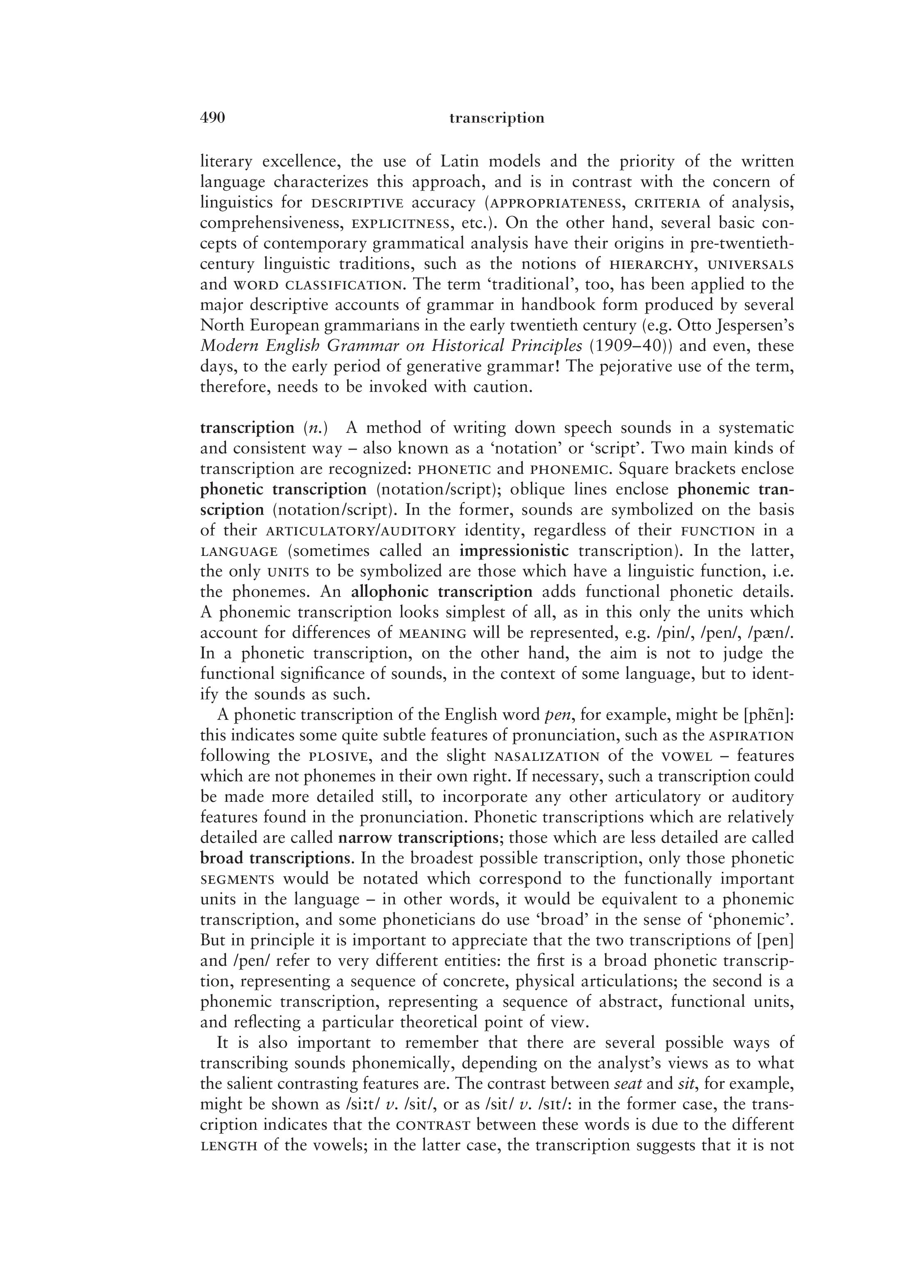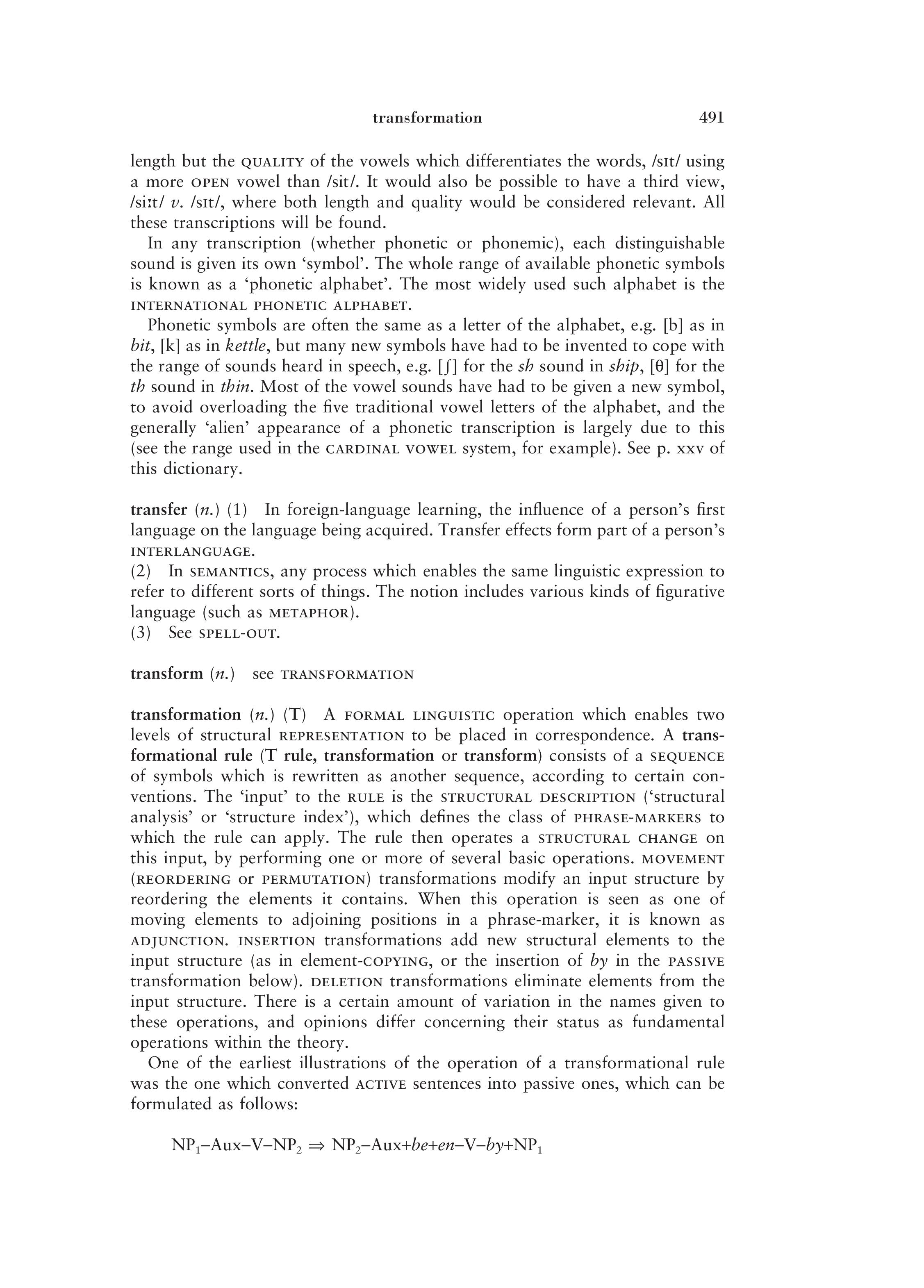Definition of Transcription
Source: A Dictionary of Linguistics and Phonetics
"transcription" n.
A method of writing down speech sounds in a systematic and consistent way – also known as a ‘notation’ or ‘script’. Two main kinds of transcription are recognized: phonetic and phonemic. Square brackets enclose phonetic transcription (notation/script); oblique lines enclose phonemic transcription (notation/script). In the former, sounds are symbolized on the basis of their articulatory/auditory identity, regardless of their function in a language (sometimes called an impressionistic transcription). In the latter, the only units to be symbolized are those which have a linguistic function, i.e. the phonemes. An allophonic transcription adds functional phonetic details. A phonemic transcription looks simplest of all, as in this only the units which account for differences of meaning will be represented, e.g. /pin/, /pen/, /pæn/. In a phonetic transcription, on the other hand, the aim is not to judge the functional significance of sounds, in the context of some language, but to identify the sounds as such.
A phonetic transcription of the English word pen, for example, might be [phɛ̃n]: this indicates some quite subtle features of pronunciation, such as the aspiration following the plosive, and the slight nasalization of the vowel – features which are not phonemes in their own right. If necessary, such a transcription could be made more detailed still, to incorporate any other articulatory or auditory features found in the pronunciation. Phonetic transcriptions which are relatively detailed are called narrow transcriptions; those which are less detailed are called broad transcriptions. In the broadest possible transcription, only those phonetic segments would be notated which correspond to the functionally important units in the language – in other words, it would be equivalent to a phonemic transcription, and some phoneticians do use ‘broad’ in the sense of ‘phonemic’. But in principle it is important to appreciate that the two transcriptions of [pen] and /pen/ refer to very different entities: the first is a broad phonetic transcription, representing a sequence of concrete, physical articulations; the second is a phonemic transcription, representing a sequence of abstract, functional units, and reflecting a particular theoretical point of view.
It is also important to remember that there are several possible ways of transcribing sounds phonemically, depending on the analyst’s views as to what the salient contrasting features are. The contrast between seat and sit, for example, might be shown as /sipt/ v. /sit/, or as /sit/ v. /s}t/: in the former case, the transcription indicates that the contrast between these words is due to the different length of the vowels; in the latter case, the transcription suggests that it is not length but the quality of the vowels which differentiates the words, /s}t/ using a more open vowel than /sit/. It would also be possible to have a third view, /sipt/ v. /s}t/, where both length and quality would be considered relevant. All these transcriptions will be found.
In any transcription (whether phonetic or phonemic), each distinguishable sound is given its own ‘symbol’. The whole range of available phonetic symbols is known as a ‘phonetic alphabet’. The most widely used such alphabet is the international phonetic alphabet.
Phonetic symbols are often the same as a letter of the alphabet, e.g. [b] as in bit, [k] as in kettle, but many new symbols have had to be invented to cope with the range of sounds heard in speech, e.g. [ ʃ ] for the sh sound in ship, [θ] for the th sound in thin. Most of the vowel sounds have had to be given a new symbol, to avoid overloading the five traditional vowel letters of the alphabet, and the generally ‘alien’ appearance of a phonetic transcription is largely due to this (see the range used in the cardinal vowel system, for example). See p. xxv of this dictionary.
Crystal, DLP, 490–491. [View as image] [Read on OMNIKA]
Page Image(s)


Citation
PsychLing Contributors. "Transcription." PsychLing, OMNIKA Foundation, 5 Aug. 2023, psylng.org/glossary/term/transcription. Accessed 6 Jan. 2026.
PsychLing (2023, August 5). Transcription. Retrieved from https://psylng.org/glossary/term/transcription
Bibliography
APA Contributors. "APA Dictionary of Psychology." Washington, DC: American Psychological Association. Accessed September 14, 2023. https://dictionary.apa.org. [Visit]
Crystal, David, ed. A Dictionary of Linguistics and Phonetics. 6ed. Malden, MA: Blackwell Publishing, 2011.
SIL International Contributors. "ScriptSource: Index of Languages and Writing Systems." Dallas, TX: SIL International. Created June 11, 2011. Accessed July 28, 2023. https://scriptsource.org. [Visit]
